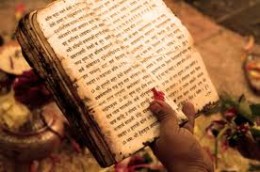
The Four Vedas
The Vedas present the broader system of Self and cosmic knowledge of which yoga and Ayurveda are specific manifestations. Both Ayurveda and yoga arose as Vedic schools, taught by lineages of Vedic seers, projecting Vedic knowledge into specific practical forms. Both look back upon Vedic texts for their authority. They follow the Vedic vision into their respective fields of health and spiritual practice.
The Vedas
In their basic formulation the Vedas are three in number and each relates to an important practice of yoga and Ayurveda:
Correspondences of the Three Vedas
| Rig Veda | Yajur Veda | Sama Veda |
| Divine Speech | Divine Prana | Divine Mind |
| Mantra Yoga | Prana Yoga | Dhyana Yoga |
| knowledge | practice | Realization |
| waking state | dream state | deep sleep |
| Earth | Atmosphere | Heaven |
| Fire (Agni) | Wind (Vayu) | Sun (Surya) |
The Vedas reflect a mantric approach that comprehends all aspects of life. They set forth the Vedic ritual, yajna or fire sacrifice, which mirrors the process of cosmic creation. Inwardly it is a yoga practice balancing agni and soma (fire and water), the perceiver and the perceived within us. This general Vedic yajna uncovers all the powers of the universe and can be used to realize all the goals of life from health to liberation.
A fourth Veda, the Atharva Veda, provides mantras for specific topics, including personal matters, and similarly covers all aspects of life. It is sometimes added to create a fourfold Vedic symbolism. In this regard the Vedas are also said to be four in number in their expanded symbolism.
Another distinction is that the Rig Veda sets forth the main deities, Devatas or cosmic powers, the different facets of Brahman or the supreme reality, and how to invoke them both in and around us. The Sama Veda sets forth the sound patterns through which these Divine energies manifest. The Yajur Veda indications the actions and transformations through which these Divine energies work. The Atharva Veda sets forth additional details on the Devatas or Divine energies and how to recognize them in all aspects of our lives down to a mundane level.
The Vedic yajna is a healing process aimed at restoring to wholeness the divine consciousness that has entered into us and become fragmented through the mind, body and senses. The purpose of the Vedic yajna is to heal or put back together the purusha or cosmic being that has sacrificed itself to become the world. This reintegration of the Creator and creation, or God and the soul, is the foundation of yoga as well, which means union. Ayurveda arises out of this Vedic urge not merely for personal healing but for healing the divine consciousness that has fallen into the material world.
The existent Vedic texts are vehicles of a deeper cosmic wisdom that is woven into all aspects of life. In this regard the Vedas are infinite and eternal. They are inherent in the cosmic Mind and manifest along with every cycle of creation as the vibrations of the divine Word through which the universe comes into being. Our soul and its creative forces work through a portion of this power.
The Vedic mantras reflect the energy of life. They are said to be inherent in prana, which is not only the life-force but the entire movement of cosmic energy. As vehicles for the cosmic prana, the Vedas possess tremendous vitality and healing power. Prana itself creates language, as speech itself arises from the breath. This creative word holds the seed or archetypal forms of creation that the Vedas portray. Through the Vedas, therefore, we gain access to the very powers of creation that can change nature itself.
Vedic mantras are the language of Mahat Tattva or Cosmic Intelligence, which has its own language of Divine sound, light, symbol and image, which transcends our ordinary human languages born of the brain and our mere human rationality. Without understanding the nature of the Vedic language and its cosmic connections, it is very difficult to make sense of the Vedas. Unfortunately most of the existing Vedic translations, such as were produced by western academic and colonial scholars, did not understand the deeper dimension of the Vedic language, and rendered them superficially as mere nature worship. Traditionally, the Vedas are said to have four or seven levels of interpretation from referring to natural processes, to explaining the nature of the Absolute Brahman beyond time and space. Later in Upanishadic thought, the inner meaning of these Vedic symbols and their philosophical connections was made evident, though it was always hidden in the Vedic mantras.
All four Vedas relate to the main families of Vedic seers or rishis that perceive them. These are the same rishis beyond the other Vedic systems of Yoga, Vedanta, Ayurveda and Vedic astrology. They include such famous Rishi lines as the Angirasas, Bhrigus, Kashyapas, Atris, Kanwas and Gotamas, as well as such famous individual seers as Vasishta, Vishwamitra, Vamadeva, Agastya, Bharadvaja, Brihaspati and Shukra. All are connected to Manu or the primal human being, described as a great Yogi who brought the seeds of culture and spirituality into the present humanity, which occurred after a great flood at the end of the last Ice Age.
There are two main parts of the Vedas. First is the mantra portion (Samhita), which is the foundation just discussed of the Vedic hymns. Second is the commentary portion, which itself consists of three parts — the Brahmanas, Aranyakas and Upanishads — making up a total of four sections. The Brahmanas deal with the details of various rituals both external and internal (yogic), individual and collective in ature. The Aranyakas are similar but have a more internal nature, providing themes for meditation and ascetic practices. The Upanishads are predominantly philosophical in nature and provide a summary of Vedic insights and knowledge. Yet the distinction between Brahmanas and Upanishads is only a matter of degree. The Brahmanas teach much spiritual wisdom or Self-knowledge and the Upanishads present rituals and practices of various types. The Upanishads provide the philosophical basis of Vedanta, yoga and the later spiritual and philosophical disciplines that derive from the Vedas.
Author: Vamadev Shastri
Acharya Pandit Vamadev Shastri ( David Frawley) is an American Hindu author, publishing on topics such as Hinduism, Yoga and Ayurveda. David Frawley is an expert in ayurveda, Vedic astrology, yoga, and tantra, all of which, he says, have their basis in Vedanta. Indeed it is the interdisciplinary approach to Vedanta that he sees as his particular contribution in demystifying eastern spirituality. David Frawley has written a number of books on all these disciplines, including Yoga and Vedanta, and Ayurveda and the Mind. His Vedic translations and historical studies on ancient India have received much acclaim, as have his journalistic works on modern India. Pandit Vamadeva Shastri was also the founder and the first president of the American Council of Vedic Astrology from 1993-2003. He is also a Patron Founder of the British Association of Vedic Astrology.
(3322)
Latest posts by Vamadev Shastri (see all)
- Vedic Dawn : The Spiritual Reawakening – November 13, 2012
- The Four Vedas – November 21, 2011
- The Six Schools of Vedic Insight – November 20, 2011



Most Hindus today knows Ramayana, Bagavath Geetha and Bagavatham but not much about Vedas. Who are the authors of Vedas, where it is teaching,how useful it to common man and where is it available ? I would like to know to share with others.